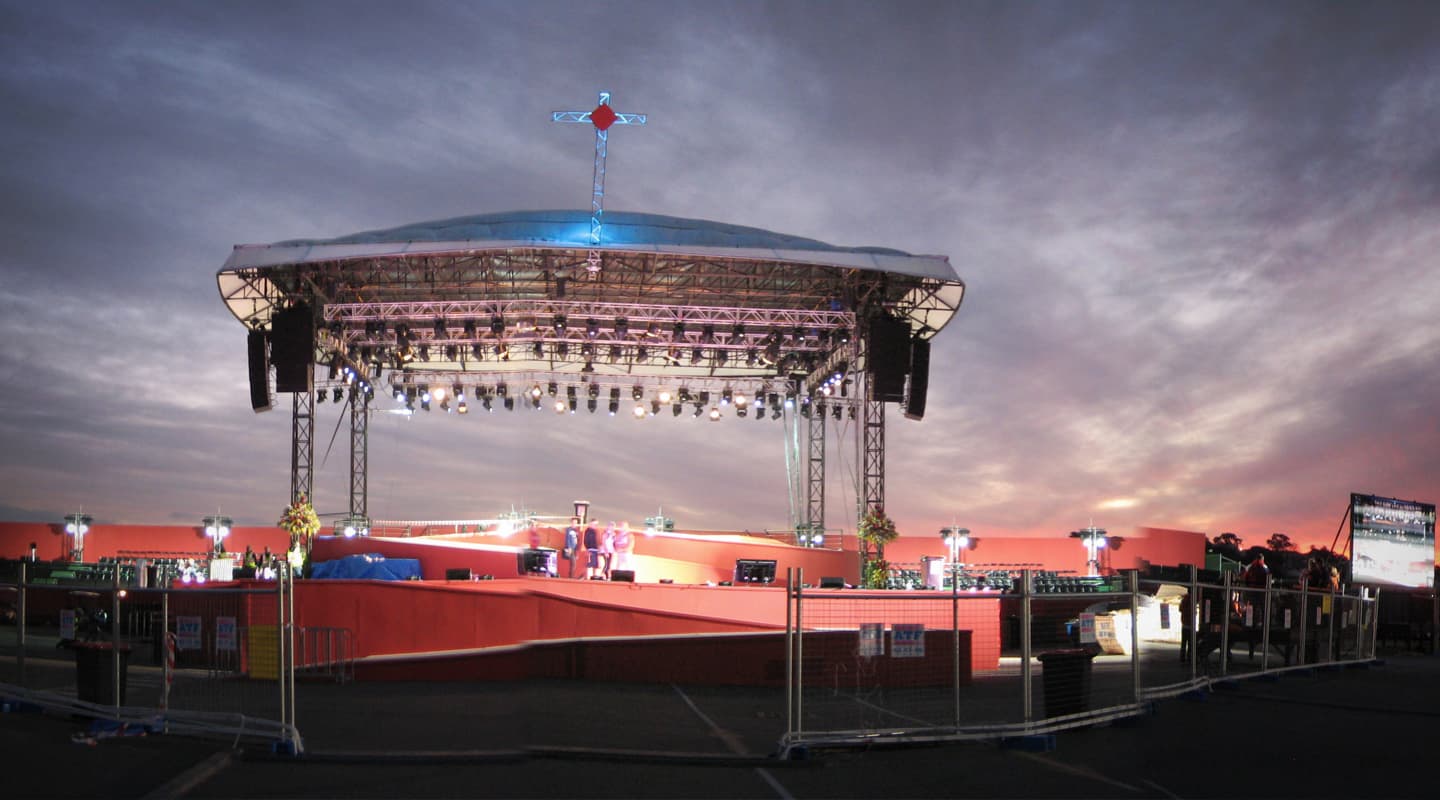
Wave If You Can Hear Me
The sheer scale of World Youth Day in Sydney presented some enormous logistical challenges.
Text:/ Tim Stackpool
Billed as the biggest event Sydney has seen since the Big Sports Carnival in Homebush (2000), World Youth Day (WYD) saw a staggering 223,000 registered Catholic pilgrims participate in any number of the week’s papal activities, making it the largest event ever hosted in Australia. But amid the celebrations and obvious front of house technology, a secure and robust talkback and communications system was devised to ensure that all production, venue management, event management and security personnel kept in touch and on cue.
The Auditoria team behind this significant undertaking was led by Ian Anderson as the head systems designer, with support from Scott Willsallen, Nick Eltis, Jason Owen and Paul Walton. “We had only 20 weeks from initial concept to delivery,” reveals Anderson. “This is a very short time frame when you consider the need to allocate spectrum by the Australian Communications and Media Authority (ACMA), obtain approvals for transmitter locations, and keep in front of requests from the organisers, such that equipment can be shipped from around the world.” Anderson is no stranger to the art of designing large-scale event communications systems. His experience already encompasses such demanding events as the 2006 Asian Games, 2006 Melbourne Commonwealth Games, Sydney 2000 Olympics, 2004 Athens Olympics, 2003 Rugby World Cup, and many Hillsong Church events.
Beyond the actual implementation, determining the requirements was a challenge in itself, and Auditoria developed their own ‘reverse brief’ based on a description of the event furnished by the World Youth Day organisers. Anderson said, “key data such as venues, amount of people expected and preliminary production crew numbers were useful pieces of information that helped us provide the reverse brief outlining the types of communication systems available, quantities available and our suggested approach to radio and wired systems.”
Meetings were held with government agencies, broadcasters, World Youth Day internal departments and other stakeholders to finally pull together the system designs. In terms of wired and venue-based systems, an approach was determined where each major venue was treated as a separate self-contained system. The major venues were Randwick Racecourse, Centennial Park, St Mary’s Cathedral, the Domain, the Sydney Opera House, Darling Harbour and Barrangaroo. During normal events these venues operated as independent systems with digital matrix intercom systems provided by Riedel. Between 12 and 40 digital key panels were installed at each site.
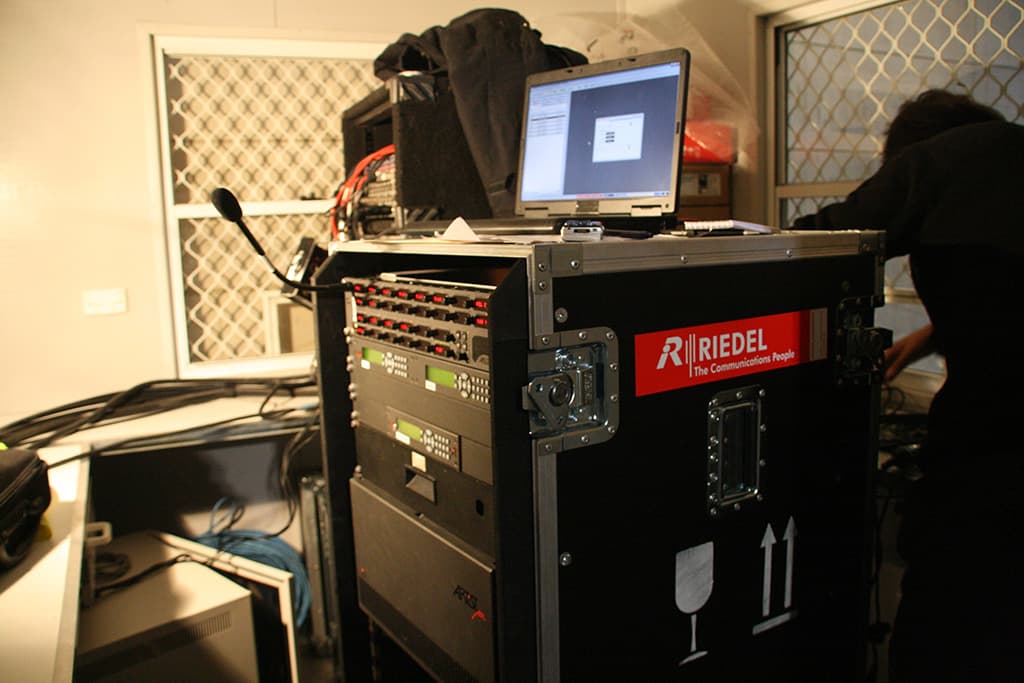
DIGITAL DEXTERITY
“The flexibility provided by digital matrix systems is vital in a situation where requirements are regularly changing. It’s equally important that changes are able to be made quickly without interrupting other users on the system,” Anderson said. “Four channel masters and classic partyline-style systems have their place, but not in environments where cable runs may be hundreds of metres and there are more possibilities of interference from external sources.” According to Anderson, the matrix systems allow seamless integration of panels, four-wire systems from outside broadcast (OB) trucks, two-way radio interfaces, full-duplex radio systems and beltpack systems. The major reason Anderson selected Riedel was their configuration flexibility. “Many of these system frames can be linked to create one complete non-blocking system,” he said. “Digital frames can be placed onstage, FOH, backstage, at event control or in an OB truck, and they will all talk to each other and act like a single frame. Riedel’s rental stock represents the largest pool of rental production communications equipment in the world, which means they can simultaneously supply systems for multiple world-class events, even events on the scale of the Beijing Olympics, Formula One racing, the Red Bull Air race and the Asian Games.”
Given the scale of the system design, the radio networks used throughout the event were provided by several different companies — Motorola Australia, Vertel and The PA People all played a significant role in providing resources to the event. It was Auditoria’s job to ensure that the supply and approach was consistently maintained within and between these organisations — the ability to communicate between the different supplier-provided networks was paramount. In this respect, the coordination was staggering. “Frequency allocation was probably the most important factor,” said Anderson. “With over 250 UHF mobile frequencies in use, on top of the already full and congested Sydney spectrum, this is not an easy task. ACMA looked at the locations and frequencies already in use, and then allocated the special out-of-band resources that were available.”
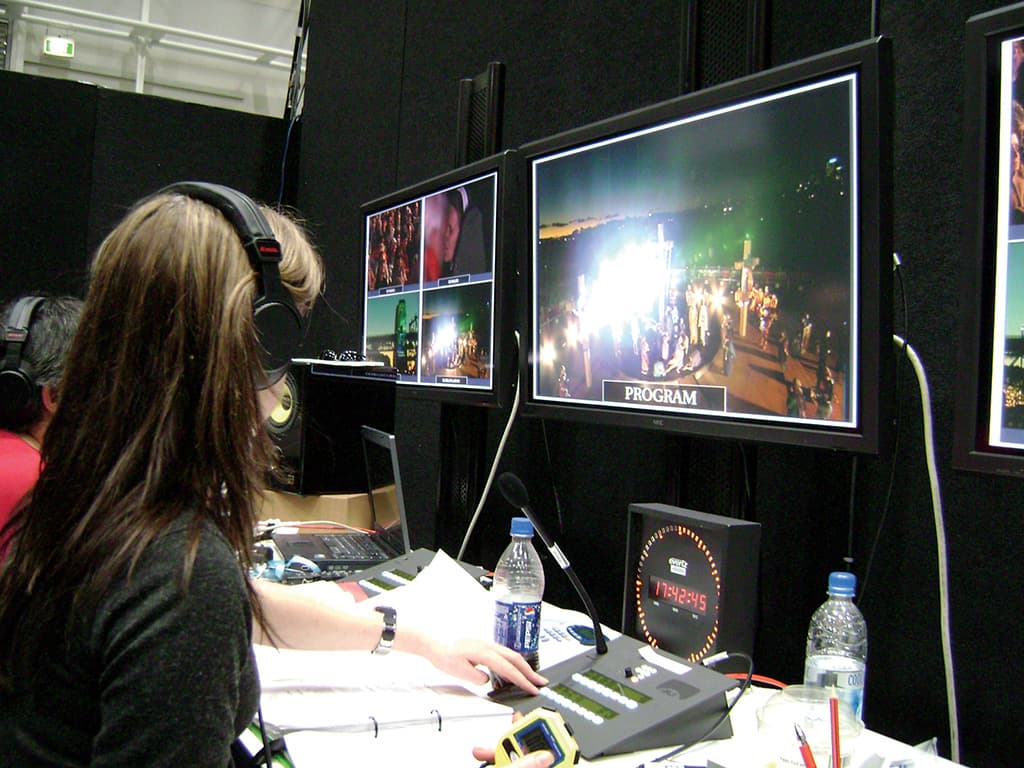
TAKE A NUMBER
The WYD communications system employed a variety of different radio systems and networks. These included Motorola Rentals 800MHz Smartnet trunked system, Motorola Rentals Digital Zeon, and Vertels Communications MPT and LTR trunked systems. Local duplex and simplex systems were also used. Over 200 Riedel digital matrix keypanels, connected to 16 Riedel Artist systems. Sites such as Barrangaroo used five Artist frames all linked with fibre to route signals around that enormous site. Over 3000 portable radios were deployed. Thirty FM transmitters were used. Many radio channels were in use through the land mobile spectrum. Over 200 frequencies were allocated to be used by WYD, ranging between 403MHz and 512MHz. The city was covered by 800MHz analogue and digital trunking systems. This doesn’t include the pre-existing licences that were in use by the rental companies, broadcasters and any Sydney-based company involved in running the event. The NSW government radio network (GRN) was also in full use dealing with many government agencies.
CHANNELLING THE WIRELESS
As more than half of the two-way radios used onsite were rental units from Europe (with its different frequency allocations), some frequencies were subsequently seconded from other areas of the UHF band. Anderson pays tribute to Brendan Puckeridge, Mark Bidwell and the teams at ACMA in Sydney and Canberra. Countless hours were spent calculating what frequencies could be used in each location and whether intermodulation difficulties might be expected with existing users. “During the event there were two teams who would hunt down any problems that we, or other essential users on the ground, might be having. Not only were we running two-way radio equipment, but there was a host of other radio users including wi-fi systems, microwave links and a very substantial FM system,” he said.
FM broadcast gear was deployed for simultaneous translation of seven major languages at all of the major sites. There was also one Sydney-wide transmission from the Optus building at North Sydney for English services. Transmission sites were located at the Domain, Barrangaroo and Darling Harbour to cover the city venues. Particularly noteworthy was the use of the same seven frequencies at each of the sites so the pilgrims could enjoy consistent reception. This necessitated extensive surveys to ensure that the antenna patterns did not overlap across the various sites. A separate transmitter array was located at the Randwick Racecourse site.
Given all of these considerations, major emphasis was given to the interfacing of wired and wireless talkback systems. At Randwick, for example, a wired system of 40 panels was installed for a range of users, some of whom also required radio interfaces for communicating with audio FOH, site management and crowd management. A total of 24 duplex and eight simplex radio interfaces were connected into the wired system. Barrangaroo had a similar number, with the other major sites using between eight and twelve duplex and four simplex interfaces.
A significant performance during World Youth Day was the Stations of the Cross, undertaken at various locations across the city. The performance re-enacts the final hours before Christ’s crucifixion, and presented its own challenges, both for the TV coverage and for the comms. A central stage management position was set up in Hall 2 at the Sydney Convention & Exhibition Centre. TV coverage images from all the performance venues were made separately available for stage management and another central communications system was installed to facilitate talkback between all of the staging, technical and lighting crews. To achieve this, a total of 24 ISDN lines and codecs were deployed to dial into each site along the route. A citywide radio system based at Sydney Tower dealt with roving stage management and lighting crews.
It not surprising to learn of one of the biggest single challenges of the project: “There was not enough physical matrix equipment in the country to do all of the venues,” reports Anderson. “Radio handheld numbers were also shy for the specific frequencies that we had to use. Obtaining comprehensive information from various stakeholders is always a challenge but this is usually because communications is one of the last things people think about. It really needs to be one of the first. We allocated one person entirely dedicated to hunting down information on handheld numbers required, as well as where and when they were going to be used. We also needed to ensure that the event’s utility suppliers, such as cleaning crews and security contractors, who use their own two-ways, did not inadvertently clash or cause interference across the spectrum.”
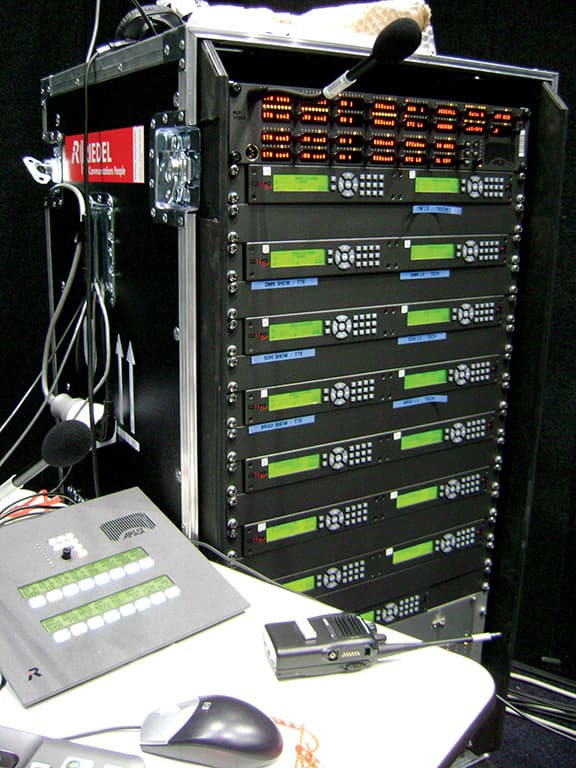
EQUIPMENT LIST
Motorola Australia:
450 x Digital Zeon portables
12 x Digital Zeon mobiles
500 x Smartnet portables
100 x Conventional portables
Vertel:
160 x MTP portable radios
LTR Trunking networks
100 x LTR portables
Riedel Communications:
160 x Artist keypanels
18 x Artist matrix frames
50 x ISDN Codecs
1800 x Radio handhelds
60 x Duplex radio interfaces
30 x Simplex radio interfaces
5 x Marine radios
Fibre backbone for frame linking
PA People:
34 x broadcast FM transmitters inc
filtering and combining.
300 x Radio Handhelds
Video Surveillance Systems for
Barangarroo and Randwick

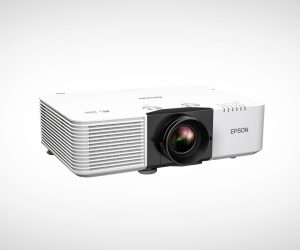
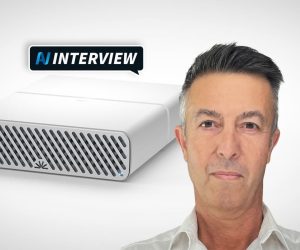

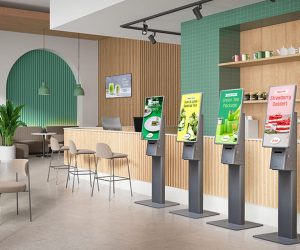
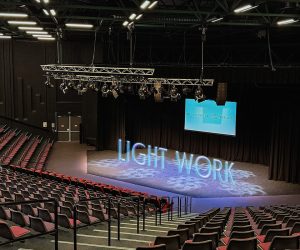

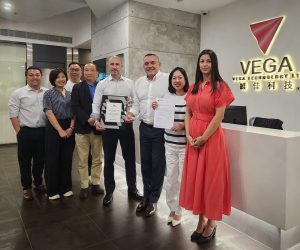
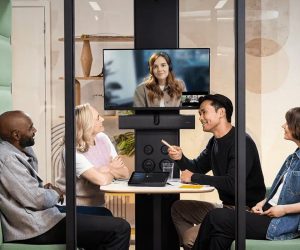
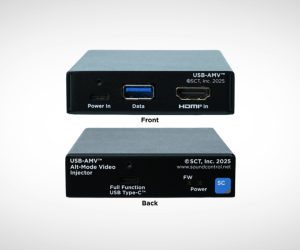


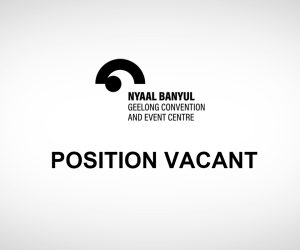
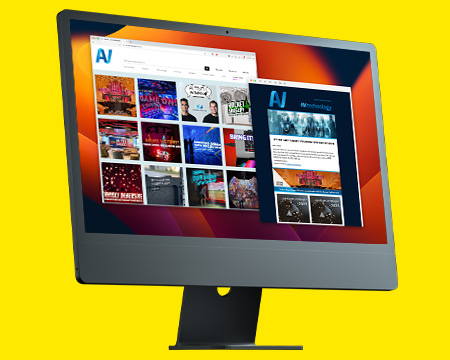

RESPONSES